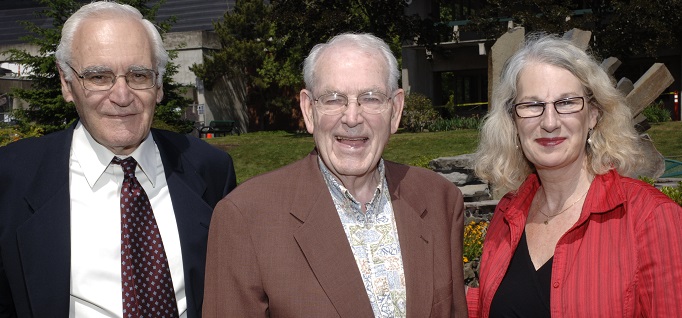The passing of a community college visionary
By CC Daily Staff
May 24, 2017
A tribute to former AACC President & CEO Dale Parnell.
Dale Parnell, who led the American Association of Community Colleges through the 1980s and championed the need to help all students transition better from high school to college and on to careers, passed away April 20 in his home state of Oregon. He was 88.
Where his predecessor Edmund Gleazer, Jr., laid a foundation for AACC’s national leadership, Parnell built on it with a vision of community colleges providing opportunity and quality for all students.
“If there’s one slogan that I developed over my 10 years in Washington, D.C., it was ‘opportunity with excellence,’” he said in an interview included in the 2011 book Legacy in Leadership: Profiles of the Presidents of the American Association of Community Colleges, 1958-2010, published by AACC and the W.K. Kellogg Foundation. “If there’s one word that describes community colleges for me, it is opportunity. And we do that in an excellent way. I never want to talk about opportunity alone.”
Many of today’s foundational concepts for community colleges were established during Parnell’s tenure as AACC president from 1981 to 1991— the associate degree was defined and created; community colleges were recognized for their importance to workforce development; and the concept of “2+2” (two years of high schools leading to two years of postsecondary education) was established.
It was his passion to better prepare high school students for college and technical careers that fueled his 1985 book The Neglected Majority, in which he outlined a plan for educating “ordinary” people who weren’t pursuing a postsecondary education. The book provided a framework for AACC to develop legislative language for a tech prep associate degree program that would build stronger relationships between high schools and community colleges.
“He laid the foundation for focusing on success for the millions of students served by community colleges, including what he called the ‘neglected majority’ of students not seeking a traditional university experience,” said AACC President and CEO Walter Bumphus. “This work provided the basis for today’s career and technical training programs that educate students to succeed in highly skilled and in-demand jobs.”
Another keystone accomplishment for Parnell at AACC was the association’s work in helping to create a blueprint for the future. In 1988, AACC published “Building Communities: A Vision for a New Century,” a report that culminated 18 months of discussions and campus visits regarding the future of community colleges, addressing issues such as partnerships, curriculum, the classroom as community and the college as community.
Challenging times in D.C.
Parnell came to Washington at a tough time, when the country was in the midst of an economic recession and the Reagan administration was threatening to trim many federal programs, including ones that were important to community colleges and their students. In addition to trying to get rid of the U.S. Education Department, the administration also wanted to drop funding for the Perkins Act, which continues to be a vital resource for CTE programs at community colleges.
“They were tough political times, but it was fun for me. I really enjoyed trying to make sure that people know about the role of the community college,” Parnell said in a 2003 interview.
He reached out to not only federal agencies, but also to business organizations and associations such as the National Association of Manufacturers.
“I wanted to make sure they knew and understood the role of the community college, and the potential for community colleges to help them” in finding well-trained employees, he said.
Parnell also helped to make AACC a key player among education circles in Washington. The growing recognition nationally of the work of community colleges placed AACC as a member of the “Big Six” higher education associations and a significant member of the Washington Higher Education Secretariat, a federation of higher education associations.
It was also during Parnell’s tenure that AACC created several of its landmark awards honoring excellence in the community college field, including the Harry S. Truman Award, the Outstanding Alumni Awards and the Leadership Award, which he himself received in 1993.
Remembering a legend
Former AACC President George Boggs lauded Parnell’s political ability to advance the cause of community colleges and for leading and strengthening 2+2 and concurrent enrollment programs. He also cited the 1988 “Building Communities” report as one the most significant documents of the community college movement at the time, adding that many of its recommendations are still valid today.
“Dale was a great cheerleader for our colleges,” Boggs said.
Parnell provided “expanded and challenging visions for American community colleges,” said John Roueche, president of the Roueche Graduate Center at National American University and a highly regarded community college expert.
Roueche, who previously ran the community college leadership program at the University of Texas at Austin, cited Neglected Majority as “emphasizing that community colleges had a more important priority in serving much better those students needing additional instructional support.”
Parnell was also a leader who pushed for great attention to student success in and out of class, Roueche said. His book Dateline 2000: The New Higher Education Agenda correctly identified most of the issues and challenges that community colleges would face in the 21st century, he said.
Bernard Luskin, chancellor of California’s Ventura County Community College District — who served at AACC as chief operations officer and executive vice president when Parnell was AACC president — also cited Parnell’s political savvy.
“Dale stood tall for community colleges, so community colleges stood tall in Washington, D.C.,” Luskin said, noting in-roads Parnell made into the Education Department, the House and Senate and among other higher education associations.
Find out more about Dale Parnell. Read the full article in CC Daily.


